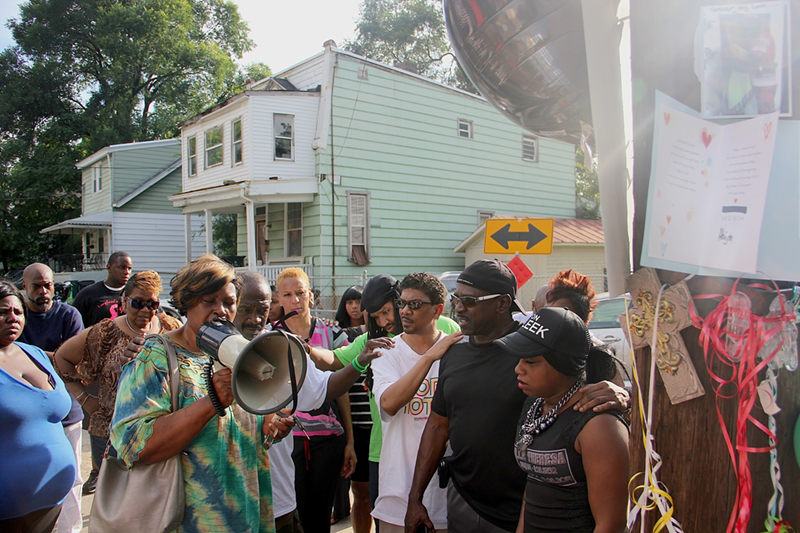
The University of Cincinnati is working on big changes to its police department but still has work ahead of it, a UCPD official said at a conference on police reform yesterday.
University of Cincinnati Police Department Director of Community Relations S. Gregory Baker called the July 19 UCPD shooting of unarmed black motorist Samuel DuBose “an atrocity” and told a crowd of about 50 that the university is pushing to get a more diverse police force, change training officers receive, add more front-line managers overseeing patrol officers and a number of other changes in the coming months.
Baker spoke at the first event of a five-night conference recognizing the 15th anniversary of civil unrest in Over-the-Rhine over the police shooting death of unarmed Timothy Thomas. Activist Iris Roley and other members of the Black United Front, which helped establish Cincinnati’s Collaborative Agreement in the wake of the unrest, organized the conference. Anti-poverty group the AMOS Project, the Hamilton County Office of Reentry, Cincinnati Metropolitan Housing Authority and a number of other groups helped sponsor the conference, which is being held at the New Prospect Baptist Church in Roselawn.
Last night’s talk focused specifically on reform efforts underway at UC after UCPD officer Ray Tensing shot and killed DuBose in Mount Auburn after a routine traffic stop for a missing front license plate. Tensing was indicted on murder charges, and UC has paid a $4.6 million settlement to DuBose’s family.
The incident, which sparked peaceful protests and national media attention, has also brought about efforts at deep change at the university, Baker says.
“Unfortunately, we had to arrive at this situation through a very tragic incident,” he said. “No amount of money will bring Mr. DuBose back, so really this reform is bigger than Mr. DuBose. We can’t pay for his life, and we don’t want this to ever happen again.”
One very specific upcoming piece of that puzzle, according to Baker: a report from independent police accountability firm Exiger that will examine department hiring practices, its diversity, its training procedures, use of force policies, traffic stops and arrests. That report will also detail suggestions for reform. It’s due out in June.
Another substantive reform that has already been implemented: The department now has sergeants supervising patrol officers, and officer behavior, stops and arrests are now being monitored for bias and racial disparities.
Those disparities have been huge. Baker says the university ramped up its police force in the years preceding the DuBose shooting, in response to a spike in crime around the university that started around 2008. The school ended up doubling the 35 officers it had in 2013 to 70 in just a year and a half. It’s now the third-largest law enforcement agency in the county behind the Cincinnati Police Department and the Hamilton County Sheriff’s Office.
With that increased enforcement came huge racial disparities. The student body on UC’s campus is only 8 percent black, though the neighborhoods surrounding it, especially to the west, have a much larger proportional black population. Increased police activity led to a disproportionate number of stops and arrests of blacks.
Traffic stops went up 300 percent to 2000 in 2015. Arrests also tripled.
But during this time, stops of white individuals actually decreased. Black stops went way up, however. Tickets written by Tensing in the year before he shot DuBose, went to blacks 81 percent of the time.
“Was it racist?” Baker asks about the disparities. “If it walks like a duck and talks like a duck…”
In the wake of the shooting, UCPD was ordered to roll back its involvement in the communities surrounding the school. Officers can now only stop a person if they are imminently threating someone or if an officer witnesses them committing a crime. Otherwise, university police must call the Cincinnati Police Department.
The department is still wrestling with what its role should be in those communities around the school, Baker says. It’s also working on gaining back trust within those communities.
The university has created a 19-member community advisor council that will weigh in on ongoing reform efforts. That council is made up of students, neighborhood residents around the university and faith leaders. Baker says it’s “very diverse.”
Other reforms are more general and are still materializing. Baker says the department is committed to increasing the number of officers of color on the force. He says that of the 72 officers currently serving in the UCPD, only one is black.
“We have to look at this one African American officer,” he said. “That’s just wrong. The police should reflect the diversity of the community. We have a problem with that at UC.”
There are still unanswered questions, however. When a CityBeat reporter asked about the other officers involved in the DuBose shooting who initially corroborated Tensing’s story in preliminary police reports, Baker shook his head.
“Those officers made statement within the urgency of the situation,” he said. “They blurted things out.” Baker pointed out they gave a more accurate accounting of events before the grand jury that indicted Tensing.
“They corrected their testimony to be consistent with the video tape,” he said. “They knew what was on the tape because they saw it themselves. That’s a very unsettled piece of this. They’re currently still working on the force.”
Baker, who spent 30 years working for the city of Cincinnati in public safety and community development before he came to UCPD in August, says he believes the department is making progress. He said the work the department is doing is vital, given concerns around crime, campus shootings and other public safety issues.
The crime issue will come up again during the five-day community-police relations conference, which also features film screenings, workshops and discussions on Cincinnati Police and the Collaborative Agreement. You can find the full schedule here.

